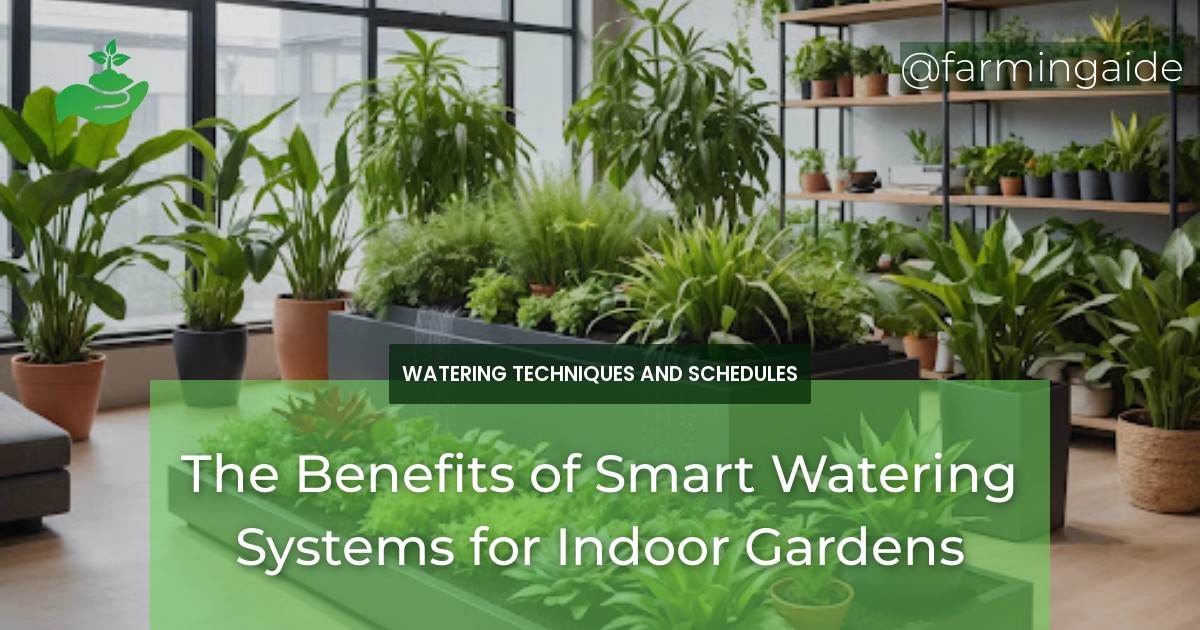Are you tired of constantly watering your indoor garden, only to find that some plants are drowning while others are parched? Do you wish you had a way to ensure your plants receive the perfect amount of water, without wasting a single drop? Look no further than smart watering systems for indoor gardens. These innovative systems take the guesswork out of watering, providing your plants with the exact amount of moisture they need to thrive. In this article, we’ll delve into the benefits of smart watering systems, explore the different types available, and provide guidance on setting up and maintaining your own system.
Key Takeaways
- Smart watering systems provide consistent and precise watering for indoor gardens.
- These systems save time and labor by automating the watering process.
- Smart watering systems conserve water by detecting soil moisture levels.
- There are various types of smart watering systems, including drip irrigation and sprinkler systems.
- Regular maintenance is essential to ensure the system functions optimally.
Introduction to Smart Watering Systems
Smart watering systems are intelligent irrigation solutions that use sensors, timers, and automation to provide your indoor garden with the perfect amount of water. These systems are designed to work in tandem with your plants’ specific watering needs, ensuring they receive the right amount of moisture at the right time. By automating the watering process, smart watering systems eliminate the risk of overwatering or underwatering, which can be detrimental to plant health.
What are Smart Watering Systems?
Smart watering systems are advanced irrigation solutions that use advanced technologies such as soil moisture sensors, weather stations, and timers to optimize watering schedules. These systems can be controlled remotely using smartphones or tablets, allowing you to monitor and adjust your watering schedule from anywhere.
How Smart Watering Systems Work
Smart watering systems work by detecting soil moisture levels and adjusting watering schedules accordingly. The system uses sensors to monitor soil moisture, and when the moisture levels drop below a certain threshold, the system activates the irrigation system to provide the necessary amount of water. This ensures that your plants receive the exact amount of water they need, without wasting a single drop.
Advantages of Using Smart Watering Systems
Smart watering systems offer numerous benefits for indoor gardeners, including:
ALSO READ
Consistent and Precise Watering
Smart watering systems provide consistent and precise watering, ensuring your plants receive the exact amount of water they need. This eliminates the risk of overwatering or underwatering, which can be detrimental to plant health.
Time and Labor Savings
Smart watering systems automate the watering process, saving you time and labor. No longer will you need to spend hours watering your plants by hand, as the system takes care of it for you.
ALSO READ
Water Conservation
Smart watering systems conserve water by detecting soil moisture levels and adjusting watering schedules accordingly. This reduces water waste and ensures that your plants receive only the amount of water they need.
Types of Smart Watering Systems for Indoor Gardens
There are various types of smart watering systems available for indoor gardens, including:
Drip Irrigation Systems
Drip irrigation systems deliver water directly to the roots of the plants, reducing evaporation and runoff. These systems are ideal for indoor gardens with multiple plants.
Sprinkler Systems
Sprinkler systems use a network of tubes and sprinkler heads to distribute water evenly throughout the garden. These systems are ideal for larger indoor gardens or gardens with a variety of plants.
Fogger Systems
Fogger systems use a fine mist to water plants, providing a consistent and gentle watering experience. These systems are ideal for delicate plants or plants that require high humidity.
Setting Up a Smart Watering System
Setting up a smart watering system is relatively straightforward, but it does require some planning and preparation:
Choosing the Right System
When choosing a smart watering system, consider the size of your indoor garden, the type of plants you have, and the level of automation you require. Research different systems and read reviews to find the best fit for your needs.
Installation Process
The installation process typically involves setting up the sensors, timers, and irrigation system. Follow the manufacturer’s instructions and take necessary safety precautions when installing the system.
Integration with Smart Home Systems
Many smart watering systems can be integrated with smart home systems, allowing you to control and monitor your watering schedule remotely using your smartphone or tablet.
Maintenance and Troubleshooting
To ensure your smart watering system functions optimally, regular maintenance is essential:
Regular Maintenance Tips
Regularly inspect the system for signs of wear and tear, clean the sensors and irrigation system, and check for software updates.
Common Issues and Solutions
Common issues with smart watering systems include clogged sensors, faulty timers, and software glitches. Refer to the manufacturer’s troubleshooting guide or contact customer support for assistance.
Conclusion: Enhancing Your Indoor Garden with Smart Watering
Smart watering systems are a game-changer for indoor gardeners, providing consistent and precise watering, time and labor savings, and water conservation. By understanding the benefits and types of smart watering systems, you can choose the perfect system for your indoor garden and enjoy a thriving and healthy plant collection.
Final Thoughts on Smart Watering Systems
Smart watering systems are revolutionizing the way we care for our indoor gardens. With their advanced technologies and automation capabilities, these systems take the guesswork out of watering, ensuring your plants receive the perfect amount of moisture to thrive.
Future Trends in Indoor Gardening Technology
As indoor gardening technology continues to evolve, we can expect to see even more advanced smart watering systems that integrate with artificial intelligence, machine learning, and the Internet of Things (IoT). These systems will provide even more precise watering schedules, automation, and monitoring capabilities, making indoor gardening easier and more enjoyable than ever.


